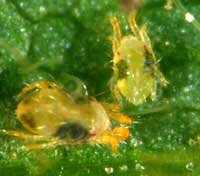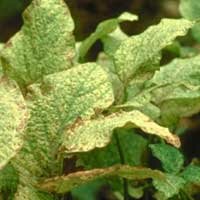
-
Soybean Diseases
- Asian Rust
- Anthracnose
- Bacterial Blight
- Bacterial Pustule
- Bean Pod Mottle Virus
- Brown Stem Rot
- Cercospora Leaf Blight
- Charcoal Rot
- Downy Mildew
- Frogeye Leaf Spot
- Green Stem Syndrome
- Iron Deficiency Chlorosis
- Phytophthora Root & Stem Rot
- Powdery Mildew
- Rhizoctonia
- Seedling Diseases
- Septoria (Brown Spot)
- SCN (Soybean Cyst Nematode)
- Soybean Mosaic Virus
- Stem Canker
- Sudden Death Syndrome
- Viruses
- White Mold
- Soybean Pests
- Diagnostic Help
- Field Trials
- Soybean Library
| Pest: Spider Mites |
Your Soybean Checkoff.
Delivering Results.
Illinois
Indiana
Iowa
Kansas
Michigan
Minnesota
Missouri
Nebraska
North Dakota
Ohio
South Dakota
Wisconsin
Two-spotted spider mite
Two-spotted spider mites (Tetranychus urticae) are present in soybean crops every year, but they are not often a significant problem. The risk of significant two-spotted spider mite infestations increases considerably during periods of hot weather and prolonged drought. For farmers and crop advisors not familiar with spider mites, the progression of symptoms from silvering, yellowing, browning, lower leaf loss and death, may be mistaken for drought symptoms.
Two-spotted spider mites have a wide host range, including soybeans, dry beans, alfalfa, corn, vegetables, ornamentals, and trees.
Mites overwinter as adults which lay eggs in the spring. Hatching mites establish colonies on the undersides of leaves that produce the webbing over the leave surface, prompting the name “spider” mites. .
How drought affects spider mite populations
Spider mite populations are held in balance by natural enemies, weather and host quality. Drought triggers spider mite outbreaks in soybean and corn by upsetting this balance in four ways.
- Accelerates spider mite movement to soybean and corn from surrounding permanent vegetation and alfalfa as it dries down or is cut for hay. Cutting initiates mass movement into adjacent soybean under drought conditions.
- Improves the food quality of soybean for spider mites.
- Diminishes or stops the activity of fungal diseases that attack mites, such as Neozygites. Disease outbreaks are fostered by cool, highly humid conditions that favor spore formation and mite infection. Hot dry weather stops these diseases.
- Speeds spider mite reproduction so that predatory insects and mites can’t keep up.
Source: Managing Two-Spotted Spider Mites on Soybeans and Corn in Minnesota - University of Minnesota Extension


